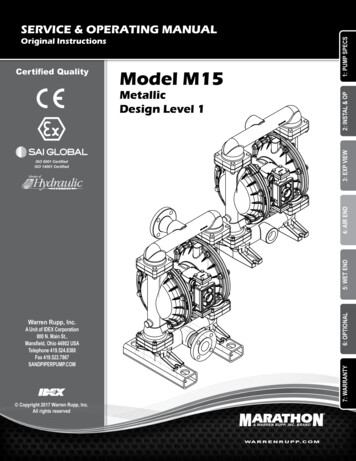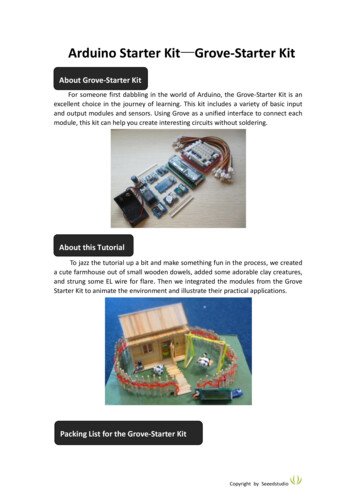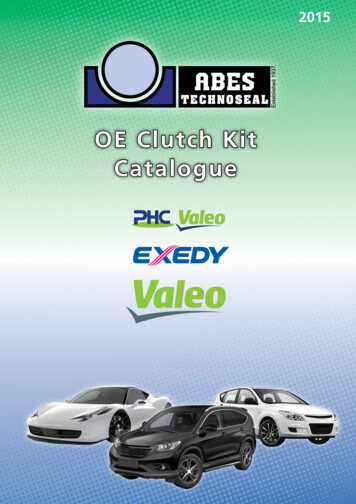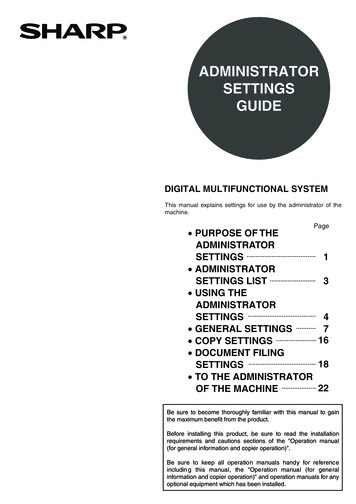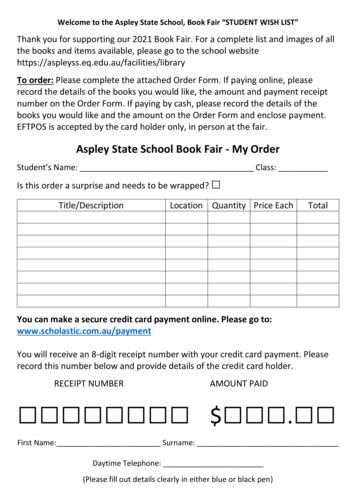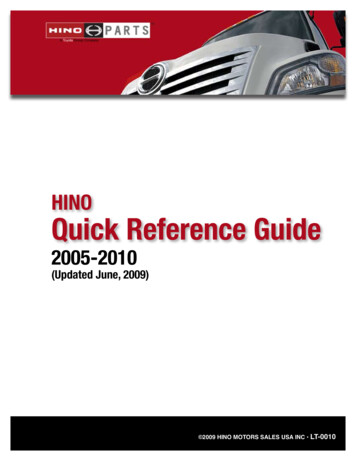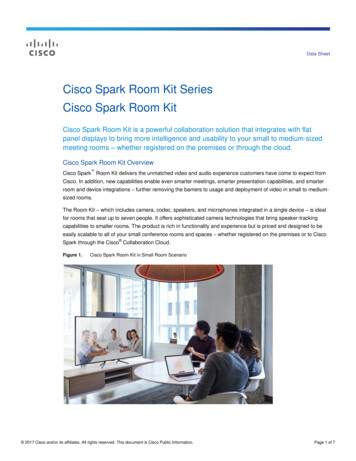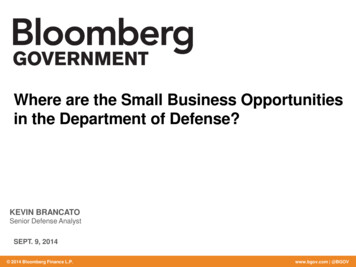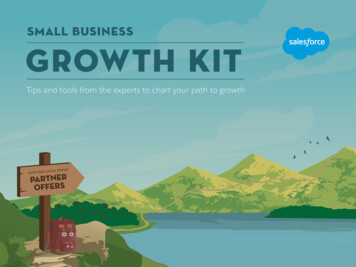
Transcription
SMALL BUSINESSGROWTH KITTips and tools from the experts to chart your path to growth
IntroductionThe trail to growth can be quite twisty-turny. But there arethree things you can think about to make the trek easier:your plan, your preparation, and the tools and solutionsyou’ll need to bring your vision to life. This kit offersguidance in all three areas. So whether you’re just startingto define your destination, or you’re already on your way,you’ll find some helpful insights here.2 Introduction
Meet Astro and Friends!As you may have noticed, the style of thise-book is inspired by the great outdoors andU.S. national parks. Why? Because they expressa feeling of fun, adventure, and explorationContentsCharting your path to growthPreparing for your journeyp. 4p. 7— and Salesforce is all about empoweringpeople to blaze their own trails and be part ofEvaluating and optimizing your toolssomething greater. Pretty cool, huh?If you want to know more, check out Trailhead,the fun way to learn about Salesforce. Getstarted today at salesforce.com/trailhead.3 IntroductionYour partner in growthp. 13p. 9
Charting your pathto growthVisionValuesGrowing your business is an uphill climb — especially withouta clear understanding of where you want to go. So how doyou map out your path?MethodsAs a market leader in sales tools and insights, Salesforcehas experienced tremendous growth. But that growth is aproduct of more than what we do and sell. It comes froma plan defined by our V2MOM process. V2MOM stands forObstaclesvision, values, methods, obstacles, and measures; and thosewords represent the five most important questions you canask yourself as you strive to grow:Vision: What do you want?Values: What’s important about it?Methods: How do you get it?Obstacles: What might stand in the way of getting it?Metrics: How will you know when you have it?4 Charting your path to growthMetrics
Chart your pathin 4 steps:Map your V2MOM.But there’s more to the process than answering thequestions. The transformative power of the process liesin sharing your answers with your team and asking yourSocialize it and get buy-in from your team.team to answer the questions, too, in the context of youranswers. (For instance, if your vision is X, their vision shouldcomplement X.)Have each team create its own, and then each employee.Then as they use their answers to perform the same processwith their own teams (and so on), everyone in the companybecomes aligned. That alignment is not only the key toRevisit throughout the year to evaluate progress.5 Charting your path to growthgrowth, but the key to achieving just about anything.
““While a companyis growing fast,there’s nothingmore importantthan constantcommunicationand completealignment. – Marc BenioffChairman & CEO, salesforce.com6 Charting your path to growth
Preparingfor your journeyA successful sales expedition requires an effective pitch. Buta good pitch is not simply about what you have to offer. It’s aframework for give and take — an adaptive model driven bythe changing needs of your buyers and the challenges youcan help them meet. With that in mind, here are a few tips toget your pitch on track.1. Do your due diligence82% of salespeople are not aligned with the needs of theirbuyers. Set yourself apart by doing your research. Knowingyour prospect’s company, industry, and competitors allowsyou to ask the right questions and tailor your message to theirspecific challenges.7 Preparing for your journey82%of salespeopleare not alignedwith the needs oftheir buyers.
2. Talk to the right person4. Think on your feetAll the research and customer information in the worldOnce your pitch is polished, don’t cling to the script.won’t help you if you aren’t in touch with the person whoTalk less and listen more, sharing only what appeals mostcan approve the purchase. Leveraging sales intelligenceto the customer. Pitches with real potential feel less like atools or social media resources like LinkedIn can helpbusiness presentation and more like a healthy conversationyou identify the best contacts to pursue.about business needs.3. Prepare for objections5. Always end with agreed next stepsAs you’re reviewing your pitch, be sure it canEvery sales pitch should end with a call to action that makesaccommodate potential sales objections. The mostsense. Even if the customer isn’t ready to complete the salecommon objections fall into four buckets:yet, be sure to keep the prospect on the journey and moveBudget: “We just don’t have the budget.”forward with a follow-up meeting or a trial period.Authority: “I need to consult with X.”Need: “I’m happy with my current solution.”Time: “We’re too busy right now.”Be prepared to discuss each objection, ideally framingit in terms of how that objection reveals a need forsales pitch worksheetyour product or service. (ie: If your product can saveDownload Nowthe customer money, that’s a great counter to the lackof budget objection.)8 Preparing for your journeyA step by step guide tobuilding your pitch.
Evaluating andoptimizing your toolsMany small business owners have no structured system fortracking their sales prospects and customer information.Of those that do, most rely on outdated tools, such asemail (44%) and spreadsheets (41%). But fast-growingcompanies do things differently. While they owe their growthto everything from product innovation to improved internalprocesses to innovative apps, one of the things that makesthe biggest difference is CRM, which stands for “CustomerRelationship Management.”Companies adding a CRM system have increased sales by asmuch as 29% and revenues by as much as 41%. While theresults are extraordinary, there’s no magic in how it works.CRM simply puts all of your critical customer information inone place and allows you to view contact info, follow up viaemail or social media, manage tasks, track performance, andmore — all within a single application. In short, finding theright CRM can translate to closing more deals, boosting sales,and improving forecast accuracy.9 Evaluating and optimizing your tools35%of small businessowners say that nothaving enough timein the day keepsthem up at night.Salesforce can help you reach your next peak,with smart sales and service automation thatgives you back the time you’ve been losing.
Is it time for you to invest in CRM?We’ve found six leading indicators that can help you answer that question, based on cases in which CRM has had the greatest impact.1. There’s no single sourcefor information.2. There’s littleor no visibility.3. You create reportsmanually or not at all.You store your customer and order informationYou have no system that lets you see what yourYou’re not using an automated resource toin more than one location, such as asalespeople are doing or how your customersproduce reports and/or analytics that mapspreadsheet or notes stuck to your computer.are connecting with employees. This makes ityour sales team’s monthly progress against itsThis puts your sales team at a disadvantage.difficult to help your sales team succeed — andquota. Because doing this by hand is tediousThey lack a single view of every customer’skeep them accountable.and painful, you’re likely not doing it as muchcontact info, orders, and interactions.as you should, if you’re doing it at all. Thisdeprives you of invaluable insights.4. Sales notes aren’tautomatically shared.5. Every customer is treatedthe same.6. You lack a planto scale fast.You lack a shared, mobile-friendly systemYou’re not able to distinguish which offers andYou’re not confident your current processesin which all salespeople keep their notes.messages are going to which targets. So thewill accommodate that growth you’re strivingThis means reps on the road can’t sharesame information is going to customers andto achieve. So you may not be able to keepnotes immediately and may forget to do soprospects in very different stages of the buyingproductivity high while scaling up.when they get home. That slows the flow ofprocess, as well as in different industries orinformation and increases the likelihood itgeographies. That means your messages arewill be lost — especially if an employee leavesnot resonating with specific needs.the company.10 Evaluating and optimizing your tools
You probably know the old saying, “there never seem to beenough hours in the day.” This is especially true in the salesworld, where time is truly money. According to a study byMavenlink, two out of five small business owners rank time astheir most valuable asset, and a quarter of those would pay 500 for just one extra hour in the day.Unfortunately, you can’t buy more time. But you can use itmore effectively and efficiently — with CRM. A CRM systemoptimizes your sales process, which means more time togenerate new prospects. A CRM system arms your sales repswith the info they need when they need it, which means ittakes less time to close sales. A CRM system allows you tosell smarter and better, which means you grow yourbusiness faster.11 Evaluating and optimizing your tools““How CRMimproves productivityTwo out of five smallbusiness ownersrank time as theirmost valuable asset,and a quarter ofthose would pay 500 for just oneextra hour in the day. – Mavenlink
at Pendo to work more efficiently and to knowknew the platform could help his company’swhere each customer is in every part of the salesefforts on both counts. So Pendo started usingand support cycles. “Our sales force has tripledSales Cloud from the company’s earliest days.in two months, and with Salesforce, we’ve beenable to maintain our speed to value,” said Olson.Salesforce is more than Pendo’s system ofWatch the Pendo story videoto learn more.record for the sale process. “If it’s not inSalesforce, it didn’t happen. That’s one of theTodd Olson and his team at Pendo have built abusiness around how digital products can helpcompanies learn from their customers, andcreate better products in the future. Backedby a Series A round of financing closed in late2015, the company is growing quickly.Pendo is CEO & Co-Founder Todd Olson’sthird startup. So when he founded theRaleigh-based company in October of 2013,Olson was already familiar with some of thechallenges commonly faced when getting anew venture off the ground — and in growingwhile maintaining mission focus. For Pendoto successfully land and expand clients, Olsonneeds his teams not only to avoid losing timeto “noise” that could be outsourced, but alsoto work across departments to find ways tooffer customers more value. Already familiar12 Evaluating and optimizing your toolsrules at the company,” Olson said. “I don’tcare what a rep tells me about how great hiscall was. If he’s not sharing it with the restof the team, he’s not contributing to helpthe company move forward.” Sales Cloudhelps Pendo’s small but growing sales teammanage the complex process of prospectinginto enterprise technology companies. ASales Cloud feature called Sales Path helps“formalize the company’s sales methodology bygiving notes to sales reps at each stage of theopportunities process. “Salesforce helps eventhe best salespeople be more successful,”said Olson.Pendo also adopted Desk.com for customersupport and Pardot for marketing automation,moving on from older systems. Running theentire business on Salesforce allows everyone“See how itworked forPendowith Salesforce dating back to 2001, OlsonSalesforce helpseven the bestsalespeople bemore successful. – TODD OLSONCo-Founder & CEO, Pendo
Your partner in growthSalesforce helps you find customers, win their business, and keep them happy so you can grow faster than ever.With Salesforce’s out-of-the-box solutions, small businesses can easily implement cutting-edge technology andconnect everything they use to run their businesses. On average, customers using Salesforce have seen a 38%faster decision making, a 25% increase in revenue, and a 35% jump in customer satisfaction.To learn more about how Salesforce can help your business, visit: salesforce.com/smbTo see how easy it is to learn Salesforce, visit: trailhead.salesforce.comc o n tac t u s13 Your partner in growth
business presentation and more like a healthy conversation about business needs. 5. Always end with agreed next steps Every sales pitch should end with a call to action that makes sense. Even if the customer isn’t ready to complete the sale yet, be sure to keep the prospect on the journey and move forward


